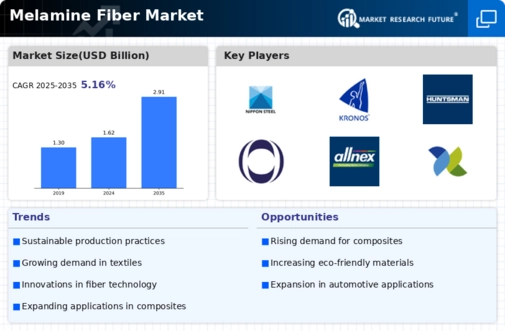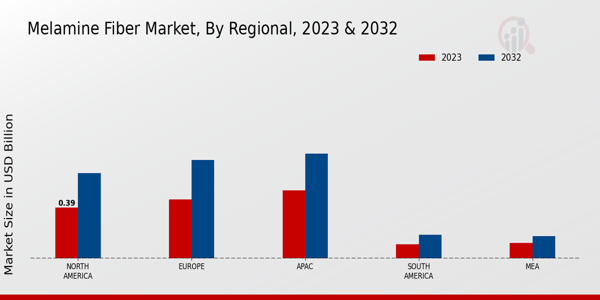Market Growth Projections
The Global Melamine Fiber Market Industry is projected to experience substantial growth over the next decade. With an estimated market value of 1.62 USD Billion in 2024, the industry is anticipated to reach 2.91 USD Billion by 2035, reflecting a robust growth trajectory. The compound annual growth rate (CAGR) of 5.47% from 2025 to 2035 indicates a strong demand for melamine fibers across various sectors. This growth is likely driven by factors such as increased industrial applications, technological advancements, and a focus on sustainability. The market's expansion presents opportunities for stakeholders to capitalize on emerging trends and innovations.
Rising Demand in Automotive Sector
The Global Melamine Fiber Market Industry experiences a notable surge in demand from the automotive sector, driven by the need for lightweight and durable materials. Melamine fibers are increasingly utilized in automotive interiors, enhancing aesthetics and performance. As manufacturers prioritize fuel efficiency and sustainability, the incorporation of melamine fibers in vehicle production appears to be a strategic choice. This trend is expected to contribute significantly to the market's growth, with projections indicating a market value of 1.62 USD Billion in 2024, potentially reaching 2.91 USD Billion by 2035. The anticipated CAGR of 5.47% from 2025 to 2035 underscores the automotive sector's pivotal role in shaping the Global Melamine Fiber Market Industry.
Growth in Construction Applications
The Global Melamine Fiber Market Industry is witnessing increased adoption in the construction sector, where melamine fibers are valued for their fire-resistant and insulating properties. These fibers are utilized in various applications, including wall panels, roofing materials, and insulation products. As global construction activities expand, particularly in emerging economies, the demand for high-performance materials like melamine fibers is likely to rise. This trend is supported by government initiatives promoting sustainable building practices, which further enhances the market's potential. The construction sector's growing reliance on melamine fibers is expected to bolster the industry's overall growth trajectory.
Diverse Applications Across Industries
The versatility of melamine fibers contributes significantly to the growth of the Global Melamine Fiber Market Industry. These fibers find applications across various sectors, including textiles, automotive, construction, and consumer goods. Their unique properties, such as heat resistance and durability, make them suitable for a wide range of products, from clothing to industrial components. As industries continue to explore innovative uses for melamine fibers, the market is likely to expand further. The increasing recognition of melamine's benefits across diverse applications suggests a promising outlook for the industry, with potential for sustained growth in the years ahead.
Technological Advancements in Fiber Production
Technological advancements in the production of melamine fibers are significantly influencing the Global Melamine Fiber Market Industry. Innovations in manufacturing processes are enhancing the quality and efficiency of melamine fiber production, leading to reduced costs and improved performance characteristics. These advancements enable manufacturers to produce fibers with superior thermal stability and chemical resistance, catering to diverse industrial applications. As companies invest in research and development to optimize production techniques, the market is likely to benefit from increased supply and competitive pricing. This technological evolution may play a crucial role in sustaining the industry's growth in the coming years.
Environmental Regulations and Sustainability Trends
The Global Melamine Fiber Market Industry is increasingly shaped by stringent environmental regulations and a growing emphasis on sustainability. Governments worldwide are implementing policies aimed at reducing carbon footprints and promoting eco-friendly materials. Melamine fibers, known for their recyclability and low environmental impact, align well with these sustainability goals. As industries seek to comply with regulations and enhance their green credentials, the demand for melamine fibers is expected to rise. This shift towards sustainable practices not only supports market growth but also encourages innovation in fiber production, further solidifying melamine's position in various applications.














